Macrame wall hanging decor can transform your living space into a haven of bohemian elegance. These handcrafted masterpieces are a stunning blend of artistry and functionality that breathe life into your walls. I really like makrame wall hangings, because they blend into my walls, but at the same time they add texture. A beautiful makrame wall hanging can also create a focal point in a cozy corner. Or complement lush greenery in a boho-chic setting. The macramé wall hanging decor offer endless possibilities.
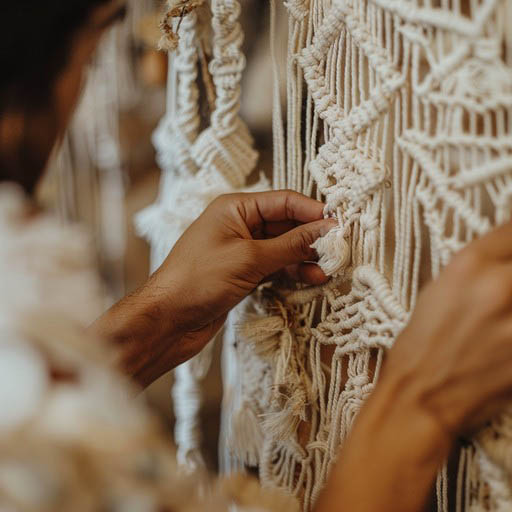
With intricate patterns, natural fibers, and a touch of free-spirited charm. The makrame wall hanging bring warmth, creativity, and a uniquely personal touch to any room.
Let macramé inspire your decor journey, turning blank walls into works of art and ordinary spaces into bohemian retreats. Lets fill them with character and beauty.
Ps: in the end of this blogpost is a DIY tutorial. You can learn how to create your own makrame wall hanging decor.
What is the Purpose of Macrame Wall Hanging?
A makrame wall hanging is perfect for bedrooms, living rooms, or entryways. Layer with tapestries or use as a statement piece to create a cozy, relaxed vibe. A makrame wall hanging come in a variety of shapes and sizes. From simple, minimalist pieces, to intricate large-scale works featuring tassels, beads, and fringe.
The Historical Roots of Makramé
Did you know that Macramé originated from 13th-century Arabic weavers who used decorative knots to finish the edges of textiles. The word “macramé” is derived from the Arabic term migramah, meaning fringe or embroidered cloth. That is highlighting its connection to ornamental detailing.
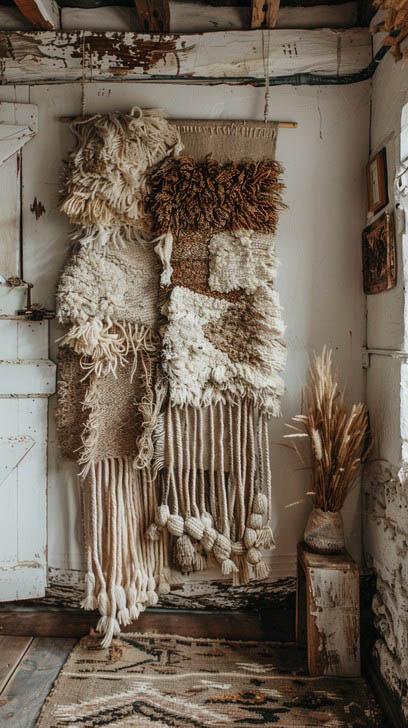
This ancient art form eventually traveled through Europe via *Moorish influence. It was evolving over centuries into the versatile and stunning craft we know today. Macramé’s timeless appeal is a testament to its rich history and the creativity of the artisans who pioneered it.
- The Moors, a North African Muslim population, brought their rich cultural traditions and artistry to Europe. Particularly to Spain, during their occupation from the 8th to the 15th centuries. The Moorish influence emphasized symmetry, intricate details, and patterns inspired by nature and geometry. These elements were seamlessly integrated into macramé designs
Macramé also found its way into Italy and France. There it was further refined and became a popular art form, particularly during the Renaissance. Nobles and royals loved Moorish designs, including macramé. It became a symbol of refinement, and elaborate macramé patterns adorned the homes, garments, and furnishings of the wealthy.
Sailors, inspired by the Moorish knotting techniques, learned the craft during their travels. That played a key role in spreading macramé globally. They used it for both practical purposes, such as securing items on ships, and for creating decorative gifts.
Macrame Wall Hanging: A Bohemian’s Guide
A makrame wall hanging is a beautiful way to bring charm and personality to any boho-inspired space. These intricate designs, made with knots and natural fibers, can transform plain walls into stunning focal points. Whether large or small, they add texture, warmth, and a unique artistic touch to your decor.
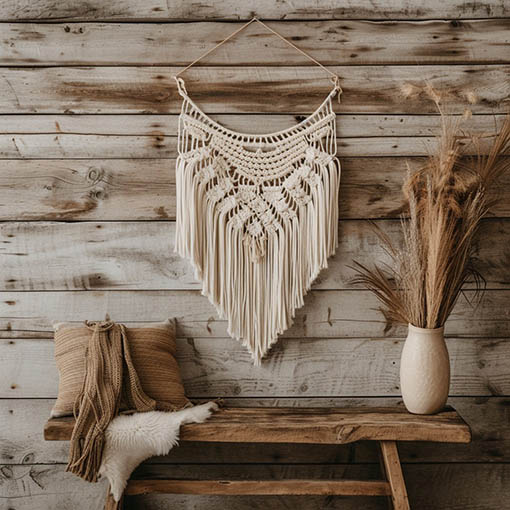
When you are choosing a makrame wall hanging, there are a variety available. Some feature simple, minimalistic patterns for a clean, modern look. Others showcase intricate designs with fringes, tassels, or geometric shapes, perfect for making bold statements. You can even find layered pieces or those combined with driftwood, beads, or feathers for a truly earthy vibe.
Creative Idéas Where to Use Your Makrame Wall Hanging
- Hang a large piece above your bed for a dreamy headboard alternative
- Place a small hanging in a hallway to add interest to an empty space.
- For living rooms, a medium-sized wall hanging pairs wonderfully with potted plants and rattan furniture.
- Use a large makrame wall hanging as a soft, boho-inspired room divider. Hang it from the ceiling between two spaces. Like a living area and dining space, to create separation without closing off the room. The flowing knots allow light to pass through while adding a sense of privacy and texture.
- Replace traditional curtains with a makrame wall hanging for a unique boho touch. Its intricate designs let sunlight filter in softly, creating beautiful shadows and patterns on your walls. This idea works especially well in cozy nooks or spaces filled with greenery.
In addition, a makrame wall hanging work well with all types of boho decor. They blend seamlessly with tapestries, woven rugs, and natural wood accents. By combining textures and patterns, you can create a cozy, free-spirited atmosphere.
No matter the style, a makrame wall hanging invites creativity and a handcrafted feel into your home. It’s a timeless decor piece that celebrates artistry and brings bohemian beauty to your walls.
What is the Best Material for Macrame Wall Hanging ?
A makrame wall hanging is typically crafted using natural and durable materials that enhance its bohemian charm. The most commonly used material is cotton cord, prized for its softness and flexibility. It’s perfect for creating intricate knots and patterns.
For a more rustic feel, jute or hemp cords are popular choices. These natural fibers have a rougher texture and earthy color. It is making them ideal for adding an organic touch to your design. Wool is sometimes used to introduce softness and a unique look. While synthetic fibers like nylon can be chosen for durability in outdoor settings. Why don´t you try and craft a makrame wall hanging for your garden?
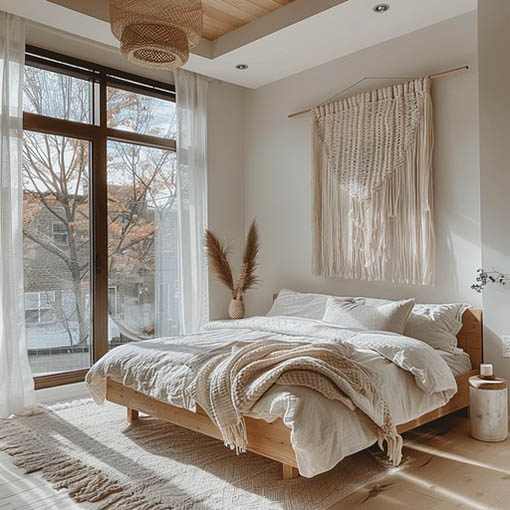
In addition to cords, many makrame wall hangings include embellishments. Wooden dowels or driftwood are commonly used as bases, adding a natural, earthy element to the piece. Beads, feathers, or shells are often incorporated into the design to give it a decorative, personalized flair.
The materials used in a makrame wall hanging not only define its aesthetic. But also make it an eco-friendly and sustainable decor option. These natural elements bring texture and beauty to any space while celebrating the artistry of handmade crafts.
Is Makramé Easy ?
Macramé is easy to learn and has been a favorite among craft enthusiasts for long. It allows for endless creative possibilities in wall art, plant hangers, and more. Making a macrame wall hanging is an easy and accessible craft that anyone can learn. Tha´s why it has become a favorite among beginners and seasoned enthusiasts alike. It involves simple knotting techniques, which can be mastered with a little practice and patience. In fact, many people find the process of knotting to be calming and meditative. Making macramé not just a craft but also a relaxing hobby.
One of the best things about macramé is its versatility. Once you learn a few basic knots, the possibilities are endless. You can create stunning wall art, elegant plant hangers, decorative curtains, or even unique keychains and jewelry.
Is Macrame a Cheap Hobby ?
There’s no need for expensive tools or materials; just some cord, a dowel, and scissors are enough to get started.
Creative Crafting with Makramé
Makramé also allows for boundless creativity. You can experiment with different cord types. Incorporate beads or other embellishments, and even dye the cords to match your personal style. Whether you prefer minimalist designs or intricate patterns, macramé gives you the freedom to express yourself through art.
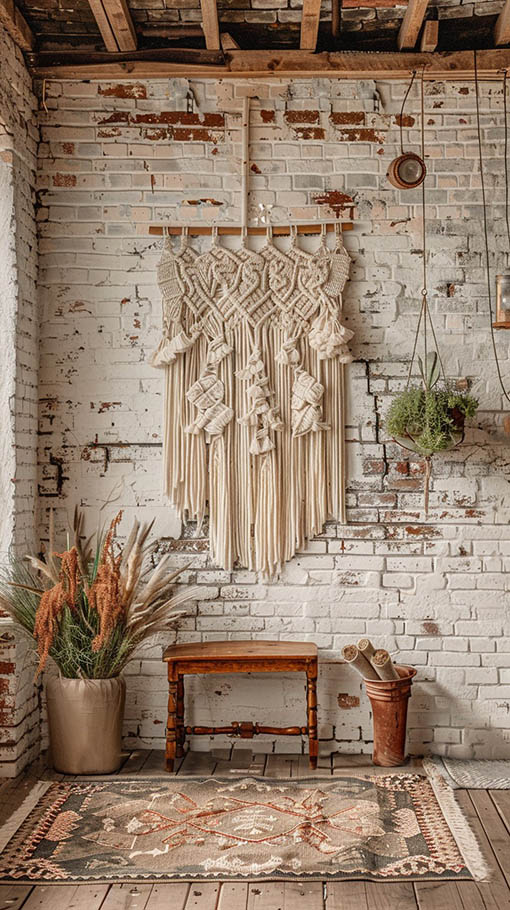
If you’re looking for a rewarding and enjoyable craft, macramé is a fantastic choice. Its simplicity, adaptability, and beauty have kept it popular for generations. And it will continue to inspire crafters all over the world.
Three Key Macramé Knots and Their Uses
Common knots include:
- Square Knot
- Description: The square knot is one of the most commonly used knots in macramé. It’s simple to learn and creates a flat, symmetrical pattern.
- Uses:
- Ideal for creating a sturdy foundation in a macrame wall hanging.
- Often used in plant hangers, allowing for a clean and structured design.
- A great knot to use for creating patterns and texture across larger projects.
- Half-Hitch Knot
- Description: The half-hitch knot is a fundamental knot used to create a diagonal, spiral effect. It’s often used to add movement and flow to macramé pieces.
- Uses:
- Commonly used to create fringes or tassels in wall hangings and plant hangers.
- Perfect for adding dimension and texture to designs.
- Great for creating a spiral pattern or soft curves in the overall structure.
- Lark’s Head Knot
- Description: The lark’s head knot is often used to attach cords to a base like a dowel or branch. It’s a simple knot that secures the cords in place and is often the first knot used when starting a macramé project.
- Uses:
- Perfect for hanging your macramé piece from a dowel or rod.
- Commonly used to start plant hangers and wall hangings.
- A foundational knot that serves as a base for more intricate designs.
Each of these knots brings a unique effect to your project, allowing you to experiment with texture, symmetry, and pattern. Once you get the hang of these basic knots, you can easily combine them to create more complex designs. That will give you endless creative possibilities. Whether you’re making a minimalist macramé piece or a more intricate design. These knots will help you bring your vision to life!
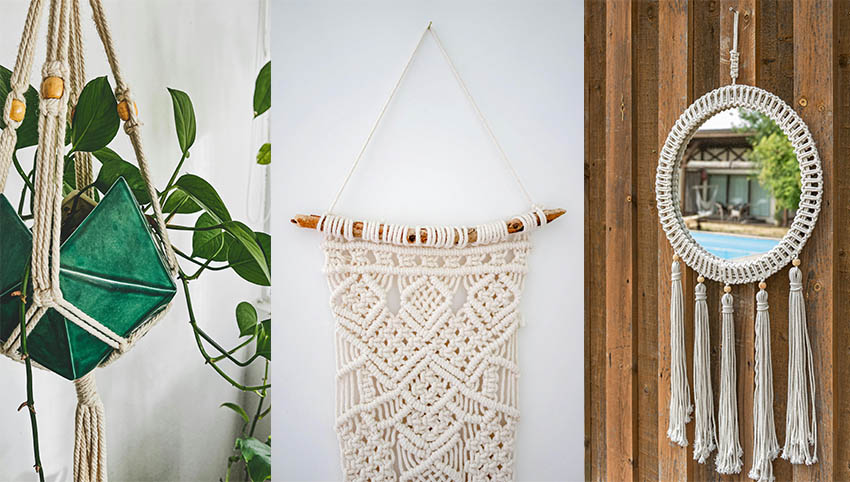
Eco-Friendly Appeal to a Makrame Wall Hanging
Most macrame wall hanging pieces uses sustainable materials and reflects a bohemian commitment to conscious living and eco-friendly aesthetics. Most macramé designs use sustainable materials. Like cotton, jute, hemp, and other natural fibers, making them a great choice for environmentally conscious crafters. These materials are biodegradable, reducing the environmental impact compared to synthetic alternatives. By choosing macramé, you support artisans who prioritize sustainability and opt for eco-friendly, ethical practices in their boho art craft.
Moreover, the macrame wall hanging reflects a broader bohemian commitment to conscious living and environmental responsibility. The boho lifestyle often values items that are handmade, unique, and sourced from nature. That is why macramé wall hangings, plant hangers, and other macramé creations have become so popular in bohemian-inspired homes. The focus is on reducing waste and embracing natural, sustainable materials that have a minimal ecological footprint.
In addition, crafting with macramé allows you to create timeless pieces that can be used for years. It will cut down on the need for disposable, mass-produced décor. As more people embrace eco-friendly living. Macramé offers a beautiful, sustainable alternative that blends artistry, nature, and environmental consciousness into one seamless design.
The Therapeutic Process in Knotting a Makrame Wall Hanging
The art of knotting a macrame wall hanging is not only a creative process but also a deeply therapeutic one. As you focus on each knot, the repetitive motion can help to calm the mind and loosen up. And also provide a sense of peace. This meditative process allows you to tune out distractions and enter a state of mindfulness. Then your thoughts slow down, and you become fully immersed in the task at hand. The act of creating with your hands brings a sense of grounding. That is making makramé to a perfect match for the bohemian lifestyle. Which emphasizes relaxation, inner peace, and connection to the present moment.
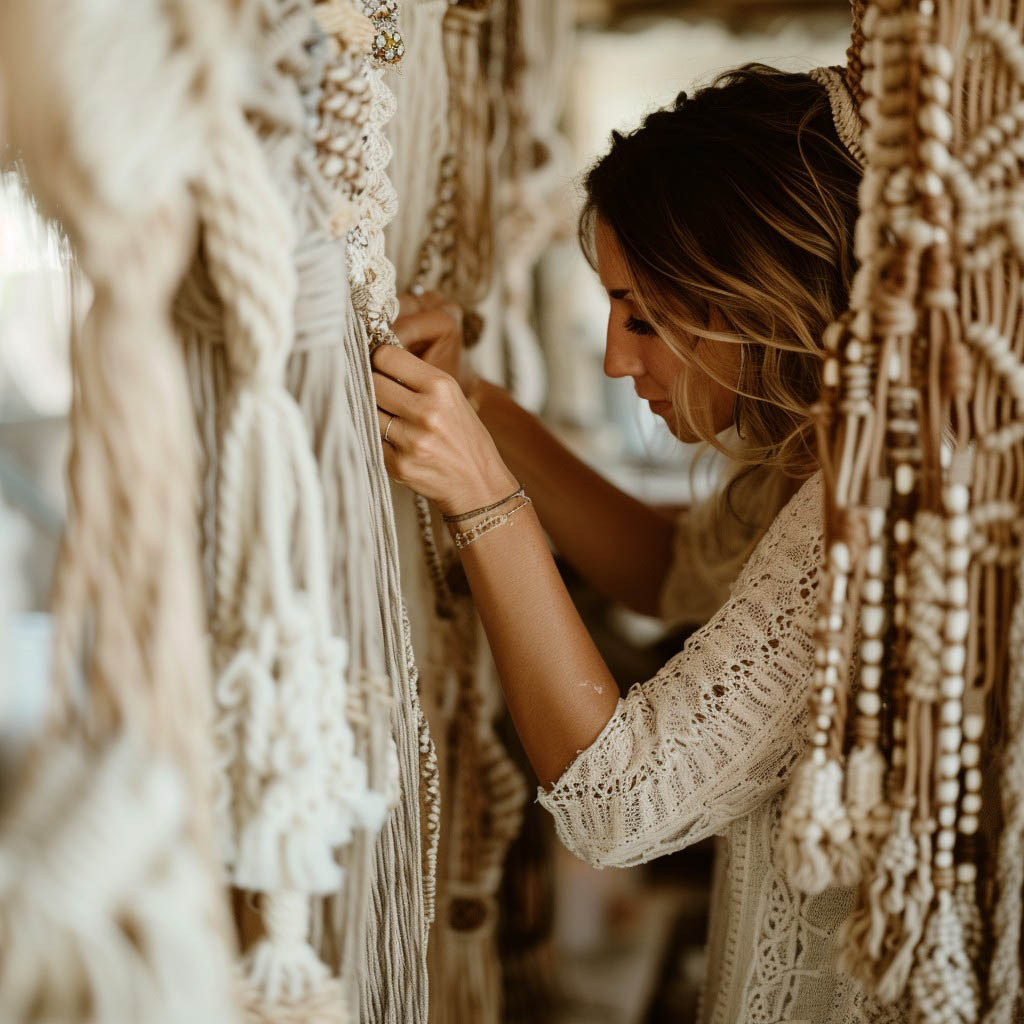
In addition, the process of knotting a makrame wall hanging can be a form of self-expression. As you experiment with different designs and patterns, you’re free to pour your emotions and creativity into the work. This freedom is therapeutic in itself. It encourages you to explore your personal style and connect with your innermost thoughts through the medium of macramé.
And, as you probably know, time seems to fly when you enter your “creative bubble.” When you’re absorbed in making something with your hands, the outside world fades away. And then you become fully engaged in the creative flow. This is when true inspiration strikes, and before you know it, hours have passed without you even realizing it. The act of knotting not only creates beautiful art. But it also provides a much-needed break for your mind. That is allowing you to feel refreshed, centered, and connected to your surroundings.
Makrame Wall Hanging Knots Carry a Spiritual Symbolism
Macrame wall hanging pieces are much more than just the result of a decorative craft. It carries deep spiritual symbolism in its knots. Many cultures throughout history have associated specific knots with powerful meanings, such as protection, luck, and connection to higher energies. These knots are not only part of the artistic process. They also serve as a reminder of the beliefs and practices of the cultures that created them. In various traditions, certain knots were believed to hold spiritual significance. Often they were woven into textiles as protective charms or symbols of prosperity.
For example, in some Native American cultures, intricate knotting patterns were believed to offer spiritual protection. They tought that they were warding off negative energies or bad spirits. Similarly, in other cultures, knots were seen as symbols of good fortune. They were meant to bring blessings to the home or to those wearing them. The act of knotting itself could be seen as a spiritual practice. Each twist and turn of the thread or cord weaving together not just fibers, but also intentions and energy.
Modern Boho and Macrame Wall Hanging Designs
In modern boho and macrame wall hanging designs, many of these ancient associations continue to hold meaning. People often create macramé wall hangings or plant hangers with specific knots to invite positive energy. That will promote healing, or protect their space. Whether it’s a simple knot or an intricate pattern, these symbols infuse everyday objects with spiritual purpose. That is adding depth and meaning to the beauty of handmade macramé pieces.
Thus, when you decorate your home with macramé. You’re not only adding a touch of bohemian charm. But also connecting to a centuries-old tradition of using knots to bring protection, abundance, and spiritual energy into your life.
How to Make a Macrame Wall Hanging – DIY Tutorial
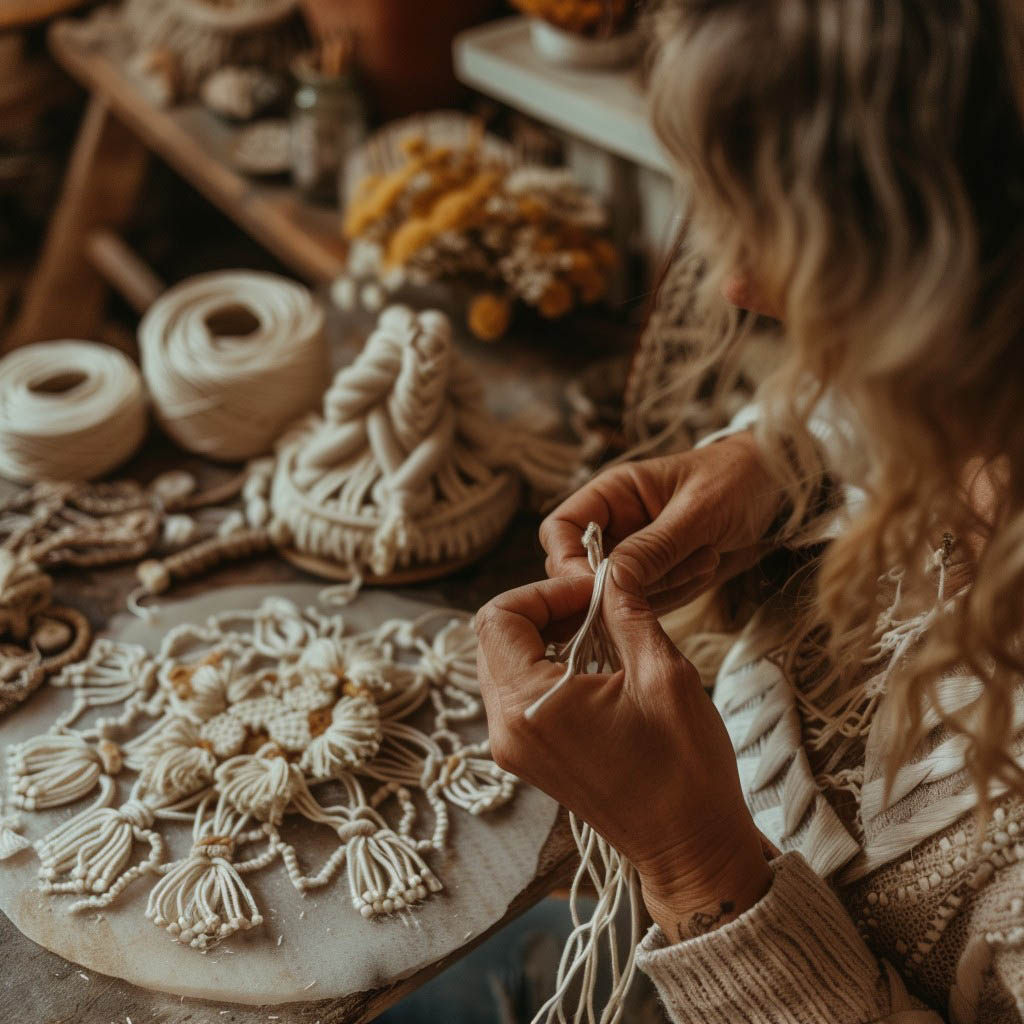
Materials You’ll Need
- Macramé Cord: Cotton rope or jute (choose the thickness based on your design).
- Wooden Dowel or Branch: Acts as the base for your hanging. Driftwood gives an earthy, bohemian vibe.
- Scissors: Sharp enough for clean cuts.
- Measuring Tape: To ensure even cord lengths.
- Optional Decorations: Beads, feathers, or dye for customization.
Steps to Make Your Own Makrame Wall Hanging
- Prepare Your Materials:
- Cut cords to the desired length (2–3 times the length of the final hanging, depending on the knot density).
- Attach cords to your dowel using the Lark’s Head Knot (loop the cord over the dowel and pull the ends through the loop).
- Learn the Basic Knots:
- Square Knot: Ideal for creating a flat design.
- Half-Hitch Knot: Great for spirals.
- Diagonal Clove Hitch: Perfect for intricate, diagonal patterns.
- Design Your Pattern:
- Start with a few rows of square knots.
- Add diagonal lines or create a diamond shape with alternating knots.
- Leave a fringe at the bottom for a free-flowing look.
- Embellish:
- Add beads by threading them onto the cords before tying knots.
- Tie feathers or charms at the ends for extra flair.
- Trim and Finish:
- Cut the fringe to your desired length, ensuring symmetry or a deliberate asymmetrical design.
- Hang and Enjoy:
- Use nails or hooks to display your wall hanging, ensuring it lies flat against the wall.
Tips for Beginners
- Start with a small, simple project to master the basic knots.
- Watch tutorials online for visual guidance.
- Use a macramé board or tape the dowel to a surface to keep it stable.
Customize Your Makrame Wall Hanging
One of the most exciting aspects of a macrame wall hanging is its incredible versatility. And the endless possibilities for customization. You can personalize your macrame wall hanging pieces by choosing from a wide range of colors. Whether it’s natural tones like cream, beige, or brown. Or vibrant, bold hues that complement your home’s decor. Dyeing the cords allows you to create a unique, one-of-a-kind design that reflects your personal style and preferences. Whether you want a soft, calming palette or a pop of boho color that stands out. The color options are limitless, making macramé a perfect craft for adding your own flair.
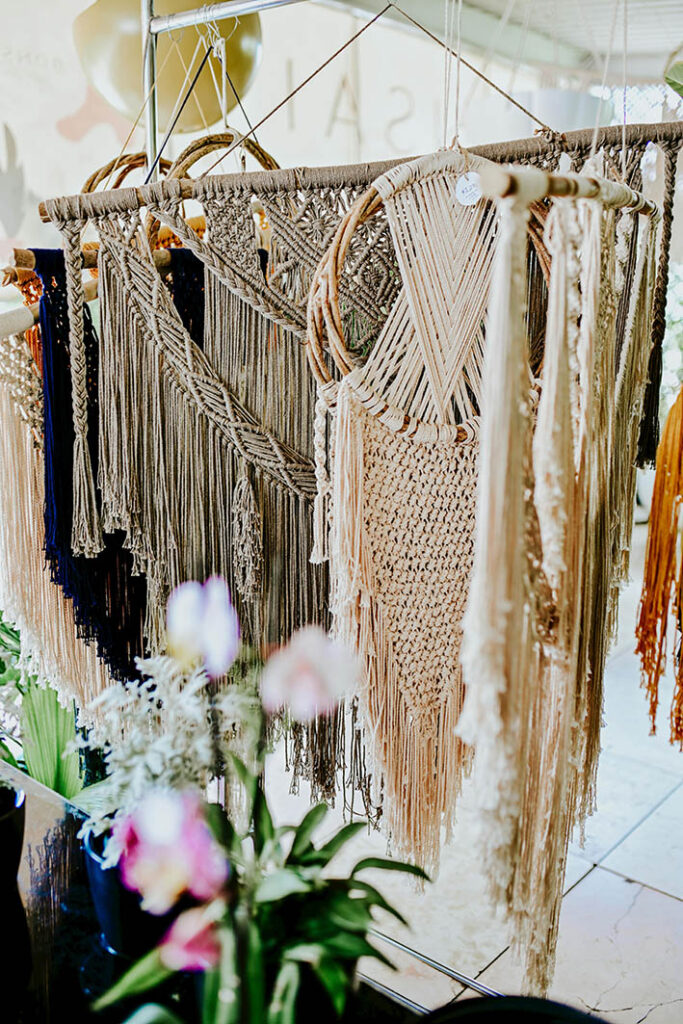
Incorporate Natural Elements in Your Makrame Wall Hanging
In addition to choosing colors, you can enhance your macrame wall hanging by incorporating other natural elements into the design. For example, driftwood can be used as a base to hang your macramé piece. That´s adding an earthy, coastal vibe to your decor. Crystals and stones can be threaded into the design. Not only as a beautiful visual accent but also for their believed healing properties. Feathers are another fantastic addition, bringing texture, movement, and a free-spirited touch to your hanging. If you’re looking for something extra whimsical, try weaving fairy lights through your macramé creation. The soft glow of the lights can add a magical atmosphere to your space. Making your makrame wall hanging not only a visual delight but a calming, ambient feature.
For those who enjoy mixing old and new, macramé is also perfect for combining traditional techniques with modern elements. For instance, blending macramé knots with sleek, contemporary designs can create a unique fusion of textures and styles. You might incorporate geometric shapes, clean lines, and minimalist patterns into your work for a modern feel. This fusion allows you to bring fresh, innovative design ideas into the classic art of the creation of a macrame wall hanging. That´s making it a versatile medium that adapts to any aesthetic. Whether you love the boho-chic style or prefer a more contemporary minimalist look. Customizing your macramé allows you to express your creativity and craft a makrame wall hanging piece that is truly yours.

